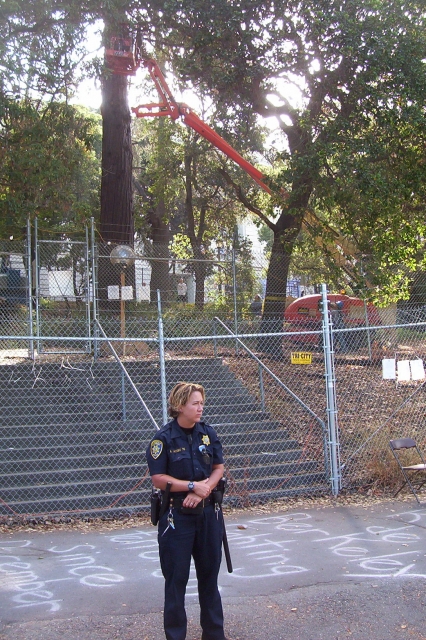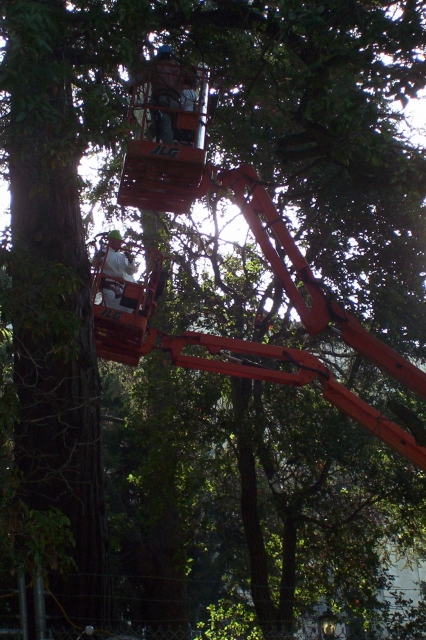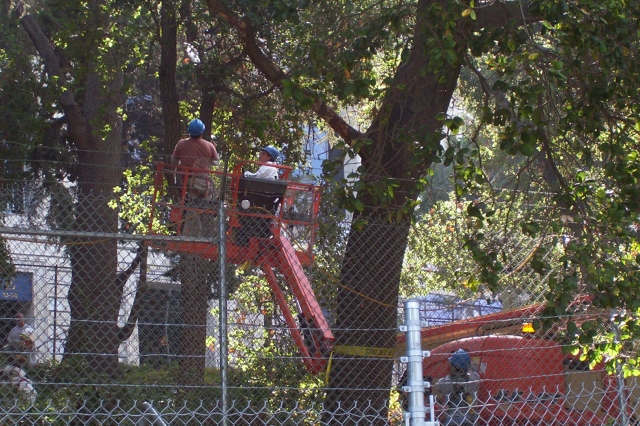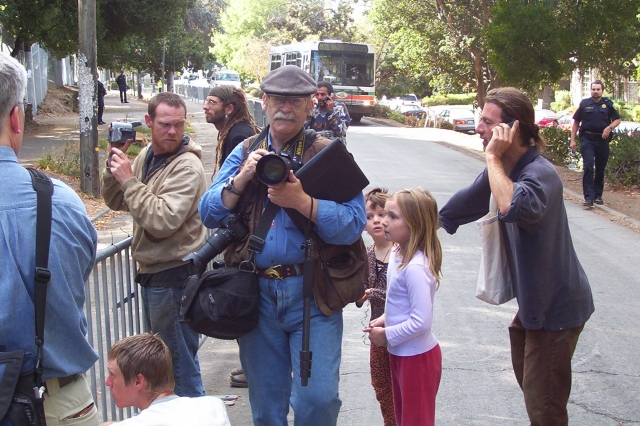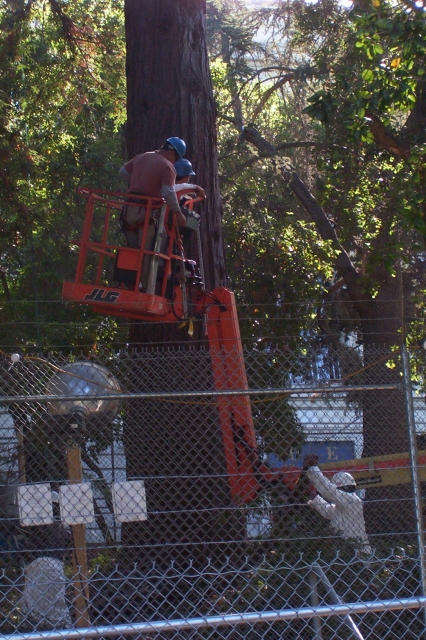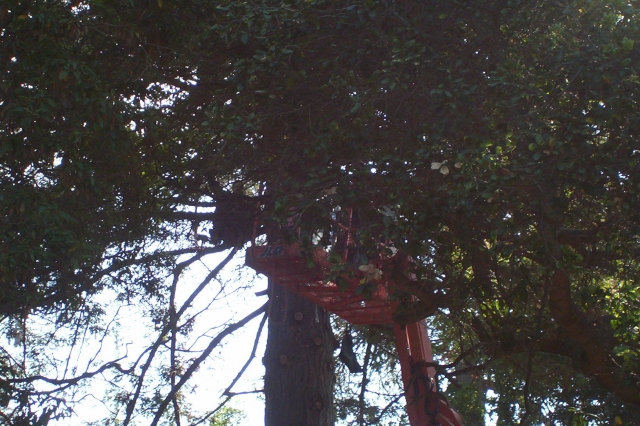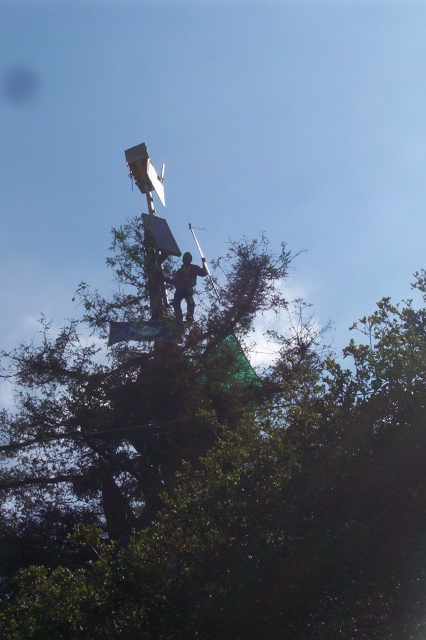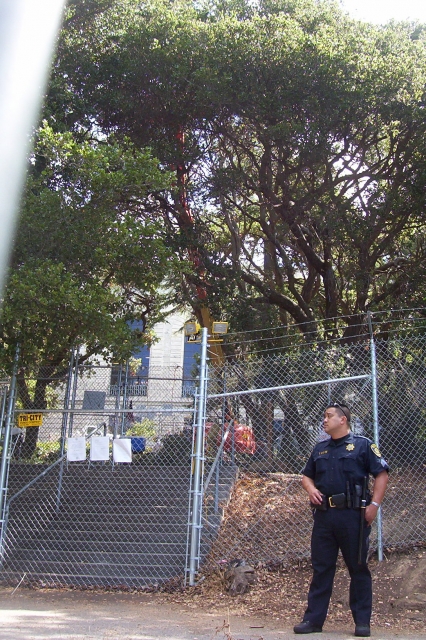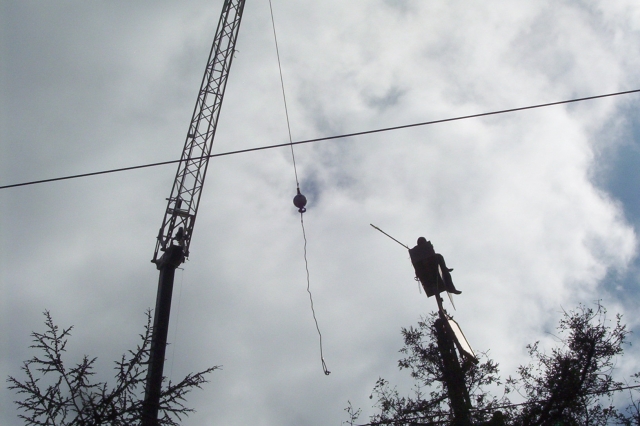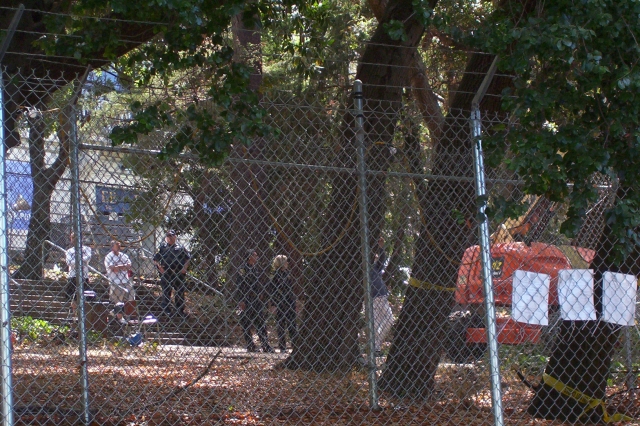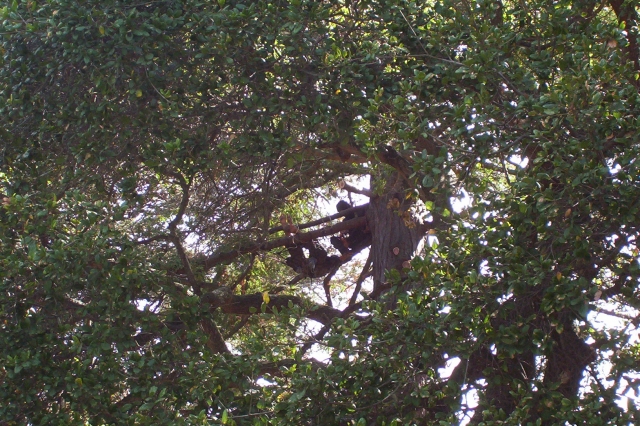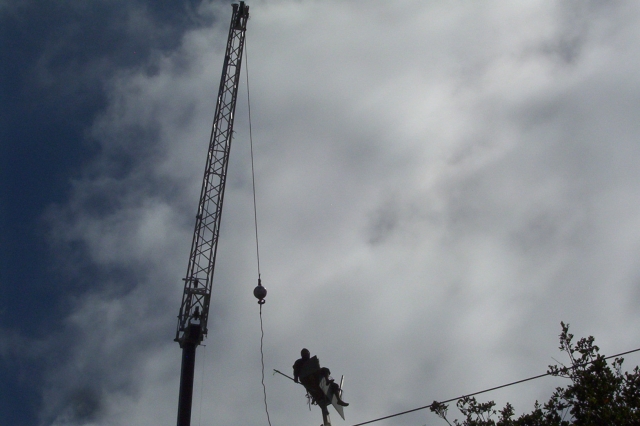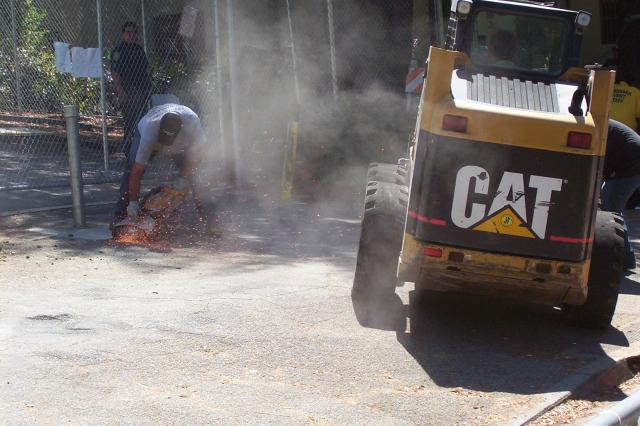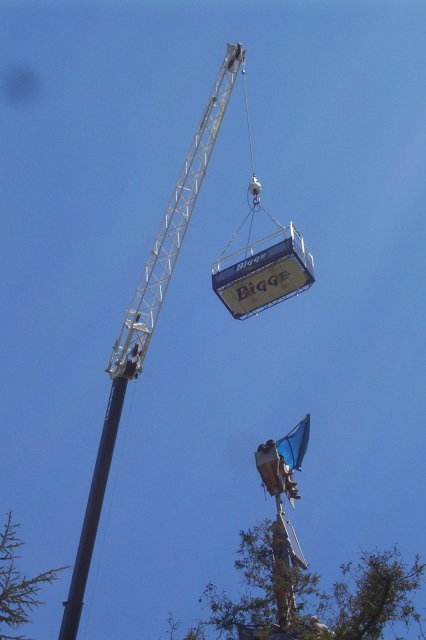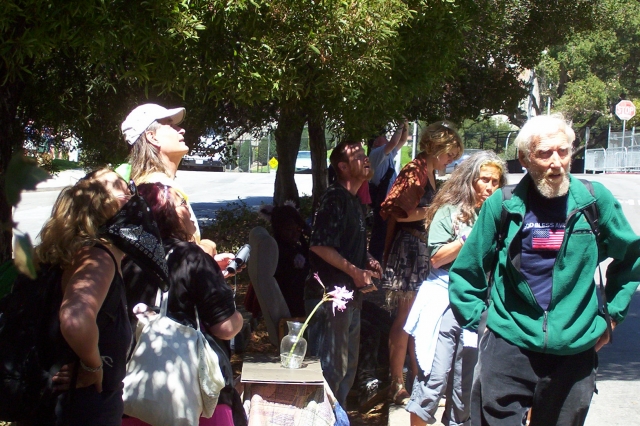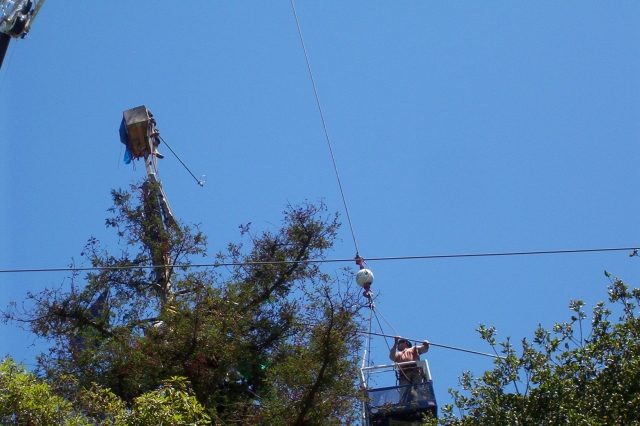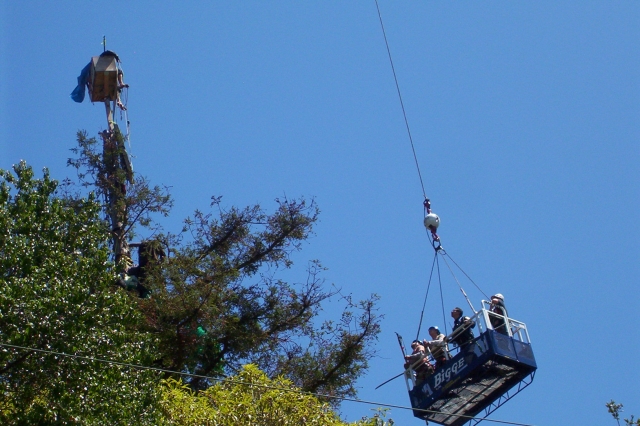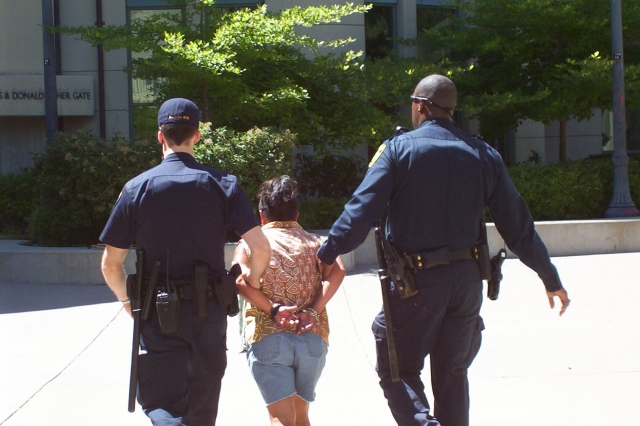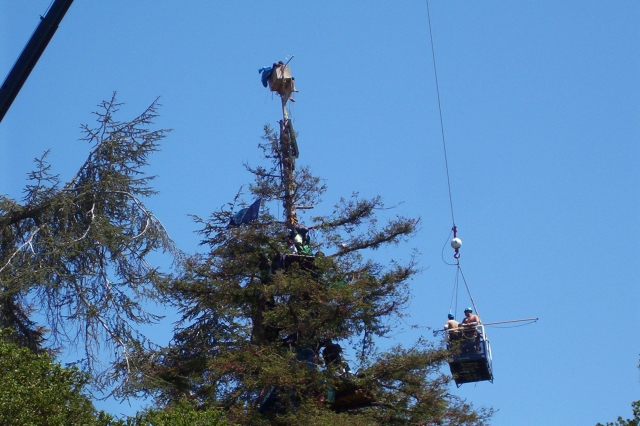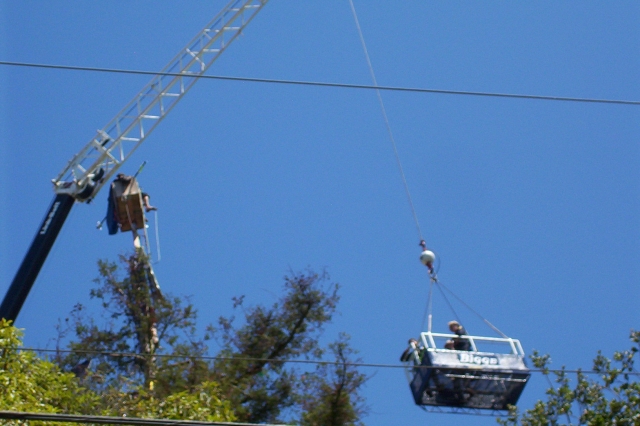From the Open-Publishing Calendar
From the Open-Publishing Newswire
Indybay Feature
Attack on Oak Grove
Extractors attack the tree sit and cut off branches and gear.
At 9:00 the university submitted a letter to Judge Miller who placed an injunction against cutting the Oak grove. Before she responded the University had arborist extractors cutting limbs off of trees. They started between 9:15 and 9:30. They cut many limbs from the redwood tree with four tee sitters in it. They were stopped from cutting more by tree sitter actions. People began to gather on the ground and decry the Universities actions and to video tape. Soon mainstream news crews were there as well. Then many limbs were cut off of two or more oak trees in the middle of the grove. Some branches were ten inches in diameter. The extractors then got their huge crane going with four people in the basket. The wet for the redwood tree and at the same time two cherry pickers with crews also attacked. Many of the extractors had pole cutters or poles with hooks. They cut down two five gallon jugs of water, several bags of food, other gear and almost succeeded in cutting down one of the platforms. They were again stopped by the heroic actions of the tree sitters.
After six hours UC Police Chief Harrison went up and spoke to the tree sitters. She said that they were done for the day.
This was a clear violation of the intent of the injunction that says that they can not cut the trees. This means, in my mind, not cut parts of the trees. They were formerly denied permission to cut branches that overhung the sidewalk. Today they said that they were just doing "strategic pruning."
I think that they wanted to make life hard on the tree sitters. More importantly they think that the injunction will hold past the first football game. This gives them a problem of how to have the grove cut off and surrounded and also get tens of thousands of fans into the game. Today they put up a fence on the southern end of the grove and will remove a piece of the fence on the west side and fans can stream through the I House parking lot. They feared people could then climb into the trees as tree sitter Jeff did some time ago. That is why they cut branches in several places to stop us from being able to climb from tree to tree to the Redwood.
for more info: saveoaks.com
After six hours UC Police Chief Harrison went up and spoke to the tree sitters. She said that they were done for the day.
This was a clear violation of the intent of the injunction that says that they can not cut the trees. This means, in my mind, not cut parts of the trees. They were formerly denied permission to cut branches that overhung the sidewalk. Today they said that they were just doing "strategic pruning."
I think that they wanted to make life hard on the tree sitters. More importantly they think that the injunction will hold past the first football game. This gives them a problem of how to have the grove cut off and surrounded and also get tens of thousands of fans into the game. Today they put up a fence on the southern end of the grove and will remove a piece of the fence on the west side and fans can stream through the I House parking lot. They feared people could then climb into the trees as tree sitter Jeff did some time ago. That is why they cut branches in several places to stop us from being able to climb from tree to tree to the Redwood.
for more info: saveoaks.com
Add Your Comments
Comments
(Hide Comments)
thanks, tristan, for the consistently great photographs giving everyone who cares a glimpse in to the oak grove crisis. the photos convey what is taking place there better than any simple written reporting can. they are very, very appreciated.
Here's another error in judgement coming from UC Berkeley administration regarding their attacks on the stadium's memorial oak grove. The oaks threatened with destruction were for the past decades responsible for stablizing the soil of this steeply sloped hill during storms and seismic events with their interwoven roots and mycorhizzal symbionts. Removing these sources of soil stability will only worsen the risks of slope failure in the event of heavy rains and/or seismic tremors. The oaks themselves may be contributing to supporting the large stadium on the plateau directly behind (upslope of) their location..
This is news to me as prior to my recent visit to the oaks i imagined them being located on a less steep surface, more like to oak groves at the UC's entrance. Was shocked as i discovered the oaks threatened with destruction were the only living organisms holding up the earthen ledge between the stadium above and the road below. That scientists hired by the UC have ignored this steep slope issue is only testament to the increasing levels of corruption dictating the current UC policy makers' agendas..
There's always a difference between the flexibility of oaks and their roots to grip the soil and the rigidity and fragile nature of concrete holding walls that eventually crack and fracture under stress..
This subject of roots and soil/slope stability is being studied and written about in some really fancy science books, and here UC Berkeley already has their soil and slope supporting oak grove thriving and they want to remove their source??
About "Eco- and Ground Bio-Engineering: The Use of Vegetation to Improve Slope Stability";
"In an era where climate change, natural catastrophes and land degradation are major issues, the conservation of soil and vegetation in mountainous or sloping regions has become an international priority. How to avoid substrate mass movement through landslides and erosion using sustainable and ecologically sound techniques is rapidly becoming a scientific domain where knowledge from many different fields is required. These proceedings bring together papers from geotechnical and civil engineers, biologists, ecologists and foresters, who discuss current problems in slope stability research, and how to address those problems using ground bio- and eco-engineering techniques.
Ground bioengineering methods integrate civil engineering techniques with natural materials to obtain fast, effective and economic methods of protecting, restoring and maintaining the environment whereas eco-engineering has been defined as a long-term ecological strategy to manage a site with regard to natural or man-made hazards. Studies on slope instability, erosion, soil hydrology, mountain ecology, land use and restoration and how to mitigate these problems using vegetation are presented by both scientists and practitioners. Papers encompass many aspects of this multidisciplinary subject, including the mechanisms and modelling of root reinforcement and the development of decision support systems, areas where significant advances have been made in recent years.
Written for:
Research scientists, postgraduate level students; managers working in the areas of slope stability, landslide mitigation techniques, erosion control, forestry, ecotechnology and environmental protection"
find book @;
http://www.springer.com/environment/soil+science/book/978-1-4020-5592-8
The UC administration has the responsibility to consider the testimony of scientists who are warning them against removing the oak roots as the primary source of slope stability. The lives and safety of the atheletes they claim to be working for by building this gym will be in their hands. Removing these oak roots places the lives of people operating in this future gym in greater risk than if other options were taken (like leave the oaks alive and standing, build gym elsewhere, etc..)..
Given that it is public knowledge of an active fault line under the stadium, it seems that retrofitting the already existing stadium would be far more logical and cost effective in the long term than adding an expensive training gym onto an unstable stadium after removing the only organisms that were providing the stadium with some degree of soil stability to begin with!!
IF the oaks are cut and the gym is built, THEN eventually there will be a seismic event and some slope failure along with structural damage to the new and expensive gym will occur, and guess who will foot the bill? Taxpayers and working class Berkeley residents, NOT the UC administration that enabled this disasterous construction project to manifest itself!!
My only other suggestion is to enlist the treesitters to volunteer with installing some climbing ropes, safety nets and other equipment into the tree canopy to be used by university atheletes as a training gym substitute. This would cost far less, enable the oaks to survive and continue providing their ecosystem services of stabilizing soils, emitting oxygen and shading the region. Of course also giving homes to countless biodiversity of birds, insects, lichens, mosses, etc...
If the UC administration is trying to "out-stubborn" the treesitters and oak tree defenders, they are playing a very dangerous game. Better they quit while they are ahead, as this warning will be taken seriously and documented, so in the event of any future seismic activity and slope failure, all names of the UC admins who approved the cutting of the oaks and construction of the stadium will be reminded that they were warned prematurely and chose to ignore these warnings that people's lives were placed in jeopardy by their short-sighted decisions. The UC admins will be held responsible for their actions..
This is news to me as prior to my recent visit to the oaks i imagined them being located on a less steep surface, more like to oak groves at the UC's entrance. Was shocked as i discovered the oaks threatened with destruction were the only living organisms holding up the earthen ledge between the stadium above and the road below. That scientists hired by the UC have ignored this steep slope issue is only testament to the increasing levels of corruption dictating the current UC policy makers' agendas..
There's always a difference between the flexibility of oaks and their roots to grip the soil and the rigidity and fragile nature of concrete holding walls that eventually crack and fracture under stress..
This subject of roots and soil/slope stability is being studied and written about in some really fancy science books, and here UC Berkeley already has their soil and slope supporting oak grove thriving and they want to remove their source??
About "Eco- and Ground Bio-Engineering: The Use of Vegetation to Improve Slope Stability";
"In an era where climate change, natural catastrophes and land degradation are major issues, the conservation of soil and vegetation in mountainous or sloping regions has become an international priority. How to avoid substrate mass movement through landslides and erosion using sustainable and ecologically sound techniques is rapidly becoming a scientific domain where knowledge from many different fields is required. These proceedings bring together papers from geotechnical and civil engineers, biologists, ecologists and foresters, who discuss current problems in slope stability research, and how to address those problems using ground bio- and eco-engineering techniques.
Ground bioengineering methods integrate civil engineering techniques with natural materials to obtain fast, effective and economic methods of protecting, restoring and maintaining the environment whereas eco-engineering has been defined as a long-term ecological strategy to manage a site with regard to natural or man-made hazards. Studies on slope instability, erosion, soil hydrology, mountain ecology, land use and restoration and how to mitigate these problems using vegetation are presented by both scientists and practitioners. Papers encompass many aspects of this multidisciplinary subject, including the mechanisms and modelling of root reinforcement and the development of decision support systems, areas where significant advances have been made in recent years.
Written for:
Research scientists, postgraduate level students; managers working in the areas of slope stability, landslide mitigation techniques, erosion control, forestry, ecotechnology and environmental protection"
find book @;
http://www.springer.com/environment/soil+science/book/978-1-4020-5592-8
The UC administration has the responsibility to consider the testimony of scientists who are warning them against removing the oak roots as the primary source of slope stability. The lives and safety of the atheletes they claim to be working for by building this gym will be in their hands. Removing these oak roots places the lives of people operating in this future gym in greater risk than if other options were taken (like leave the oaks alive and standing, build gym elsewhere, etc..)..
Given that it is public knowledge of an active fault line under the stadium, it seems that retrofitting the already existing stadium would be far more logical and cost effective in the long term than adding an expensive training gym onto an unstable stadium after removing the only organisms that were providing the stadium with some degree of soil stability to begin with!!
IF the oaks are cut and the gym is built, THEN eventually there will be a seismic event and some slope failure along with structural damage to the new and expensive gym will occur, and guess who will foot the bill? Taxpayers and working class Berkeley residents, NOT the UC administration that enabled this disasterous construction project to manifest itself!!
My only other suggestion is to enlist the treesitters to volunteer with installing some climbing ropes, safety nets and other equipment into the tree canopy to be used by university atheletes as a training gym substitute. This would cost far less, enable the oaks to survive and continue providing their ecosystem services of stabilizing soils, emitting oxygen and shading the region. Of course also giving homes to countless biodiversity of birds, insects, lichens, mosses, etc...
If the UC administration is trying to "out-stubborn" the treesitters and oak tree defenders, they are playing a very dangerous game. Better they quit while they are ahead, as this warning will be taken seriously and documented, so in the event of any future seismic activity and slope failure, all names of the UC admins who approved the cutting of the oaks and construction of the stadium will be reminded that they were warned prematurely and chose to ignore these warnings that people's lives were placed in jeopardy by their short-sighted decisions. The UC admins will be held responsible for their actions..
The University went to the judge who issued the injunction before pruning the trees and showed her everything they planned to do. She agreed it was not a violation.
You can keep saying that it is, but the judge is the final authority and you are wrong.
You can keep saying that it is, but the judge is the final authority and you are wrong.
I think you're a bit confused. There are no major drain and oil stability issues below the stadium, it's a narrow strip that doesn't get much rain drained into it due to the presence of the wide stadium bowl. You do realize that the world's foremost experts on geotechnical issues practice their research and teaching a block below the stadium, within Cal's top-rated Civil Engineering dept. Their input was taken.
It's also disingenuous to worry about the safety of athletes due to mudslide potential (very dubious threat at best) when in fact they are currently in far greater danger from being inside a seismically unstable structure on a daily basis. That's one of the main purposes of the new construction that many here are fanatically devoted to blocking, it is going to take them out of harm's way and put them in a new seismically safe structure.
Anyway, we're basically at the endgame now, the courts have rightfully declared UC to be the winners, the 44 trees will come down, but a hundred more will be replanted, and eventually the parking area north of the stadium will also get an oak tree cover. Twenty years from now the area will actually be greener, that's a fact that underscores the futility and plain wrongness of this whole treesit.
While you can't expect guys like tristan or "Running Wolf" to be realistic and rational (as are half of Berkeley's city council, who abstained from voting for a futile and costly appeal), it's time for most people to move on.
All this attention to this "sexy" treesit is all the more depressing given that there are much more urgent environmental issues right now which would warrant the focus of the treesitters, like the contunied threats on the Headwaters old growth groves. Someone should tell the handful of protesters near the stadium to move there already.
It's also disingenuous to worry about the safety of athletes due to mudslide potential (very dubious threat at best) when in fact they are currently in far greater danger from being inside a seismically unstable structure on a daily basis. That's one of the main purposes of the new construction that many here are fanatically devoted to blocking, it is going to take them out of harm's way and put them in a new seismically safe structure.
Anyway, we're basically at the endgame now, the courts have rightfully declared UC to be the winners, the 44 trees will come down, but a hundred more will be replanted, and eventually the parking area north of the stadium will also get an oak tree cover. Twenty years from now the area will actually be greener, that's a fact that underscores the futility and plain wrongness of this whole treesit.
While you can't expect guys like tristan or "Running Wolf" to be realistic and rational (as are half of Berkeley's city council, who abstained from voting for a futile and costly appeal), it's time for most people to move on.
All this attention to this "sexy" treesit is all the more depressing given that there are much more urgent environmental issues right now which would warrant the focus of the treesitters, like the contunied threats on the Headwaters old growth groves. Someone should tell the handful of protesters near the stadium to move there already.
Whats the lastest?
Berkeleyan wrote;
"I think you're a bit confused. There are no major drain and oil stability issues below the stadium, it's a narrow strip that doesn't get much rain drained into it due to the presence of the wide stadium bowl. You do realize that the world's foremost experts on geotechnical issues practice their research and teaching a block below the stadium, within Cal's top-rated Civil Engineering dept. Their input was taken."
So just because some scientists employed by UC Berkeley have made a choice to compromise their integrity and they are experts, well by golly, we’d all better believe them? Just like we should believe the scientists working under the GW bush regime’s EPA climate change panel that distort the facts in order to keep the people of the U.S. hooked on oil for another few decades??
How many HONEST scientists working for the GW Bush regime’s climate change panel were able to remain employed without losing their lunch on a daily basis after watching their work be repeatedly distorted for the benefit of GW’s buddies in big oil?
There are plenty of scientists who disagree with the decisions of the GW bush regime, UC Berkeley administration and other authorities who use their power to distort science. When Prof. Ignacio Chapela discovered that GMO pollen had contaminated the indigenous land races of maize in Oaxaca, he went public with this important knowledge and was denied tenure by UC Berkeley administration as a result of his integrity. That shows the difference between scientists who care about presenting the facts and other so-called scientific experts who distort science to please their bosses..
AS far as the drainage, how can a stadium that is next to the oaks in the median prevent rain from falling on the median and the oaks themselves? The stadium is not an umbrella, it sits next to the median, NOT on top of it! If the oaks are removed, there will be no protection of the soil beneath, and smothering with concrete doesn’t count as adequate protection. If rainstorms were the only problem, that would be one thing, but we remind ourselves that the stadium above the oaks is sitting on an active fault line, so add liquefaction the recipe of possible disasters. Oak roots that grip the soil would prevent these types of events from happening, liquefaction is usually for mud and unstable soil saturated by moisture and becomes like pudding, unable to maintain it’s structure in the event of a seismic tremor.
Although I am not worried about the safety of the athletes yet, i would not feel safe working out in a gymnasium built under these conditions. The stadium behind the oaks and potential gym site is already unstable, so how does attaching a new building to a much larger unstable one guarantee anybody’s safety?
"I think you're a bit confused. There are no major drain and oil stability issues below the stadium, it's a narrow strip that doesn't get much rain drained into it due to the presence of the wide stadium bowl. You do realize that the world's foremost experts on geotechnical issues practice their research and teaching a block below the stadium, within Cal's top-rated Civil Engineering dept. Their input was taken."
So just because some scientists employed by UC Berkeley have made a choice to compromise their integrity and they are experts, well by golly, we’d all better believe them? Just like we should believe the scientists working under the GW bush regime’s EPA climate change panel that distort the facts in order to keep the people of the U.S. hooked on oil for another few decades??
How many HONEST scientists working for the GW Bush regime’s climate change panel were able to remain employed without losing their lunch on a daily basis after watching their work be repeatedly distorted for the benefit of GW’s buddies in big oil?
There are plenty of scientists who disagree with the decisions of the GW bush regime, UC Berkeley administration and other authorities who use their power to distort science. When Prof. Ignacio Chapela discovered that GMO pollen had contaminated the indigenous land races of maize in Oaxaca, he went public with this important knowledge and was denied tenure by UC Berkeley administration as a result of his integrity. That shows the difference between scientists who care about presenting the facts and other so-called scientific experts who distort science to please their bosses..
AS far as the drainage, how can a stadium that is next to the oaks in the median prevent rain from falling on the median and the oaks themselves? The stadium is not an umbrella, it sits next to the median, NOT on top of it! If the oaks are removed, there will be no protection of the soil beneath, and smothering with concrete doesn’t count as adequate protection. If rainstorms were the only problem, that would be one thing, but we remind ourselves that the stadium above the oaks is sitting on an active fault line, so add liquefaction the recipe of possible disasters. Oak roots that grip the soil would prevent these types of events from happening, liquefaction is usually for mud and unstable soil saturated by moisture and becomes like pudding, unable to maintain it’s structure in the event of a seismic tremor.
Although I am not worried about the safety of the athletes yet, i would not feel safe working out in a gymnasium built under these conditions. The stadium behind the oaks and potential gym site is already unstable, so how does attaching a new building to a much larger unstable one guarantee anybody’s safety?
Some scientists in Scotland (with climate & topography similar to Bay Area) have also noticed the links between deforestation and debris flows, landslides, etc…
“The effects of forestry have frequently been identified as, at least, partial causes or propagators of debris flows in areas such as the Pacific NW of the USA (Brunengo, 2002). Logging or deforestation can have a dramatic effect on the drainage patterns of a slope, reducing root moisture uptake, slope reinforcement due to the root systems, and the physical restraints on downslope water flow for example. Such effects were especially noted as factors in the triggering of a translational landslide (not a debris flow) at Loch Shira adjacent to the A83 trunk road near Inverary in December 1994.”
Entire report found @;
http://www.scotland.gov.uk/Publications/2005/07/08131738/17457
Here’s some basics on different types of “mass wasting”, the term used for soil and slope erosion;
Mass wasting
(′mas ′wāst•iŋ)
(geology) Dislodgement and downslope transport of loose rock and soil material under the direct influence of gravitational body stresses.
Types of mass movement
Types of mass movement are distinguished based on how the soil, regolith or rock moves downslope as a whole.
Creep
Creep is a long term process. The combination of small movements of soil or rock in different directions over time are directed by gravity gradually downslope. The steeper the slope, the faster the creep. The creep makes trees and other shrubs curve to reach the sun light. These often trigger land slides because the dirt underneath is not very strong. The trees most of the time die out because of lack of water and sun, and these rarely happen in wet climates.
Landslides
Where the mass movement has a well-defined zone or plane of sliding, it is called a landslide. This includes rock slides, slumps and sturzstroms.
Flows
Movement of soil and regolith that more resembles fluid behavior is called a flow. These include avalanches, mudflows, debris flows, earth flow, solifluction, lahars and sturztroms. Water, air and ice are often involved in enabling fluidlike motion of the material.
Topples
Topples are instances when blocks of rock pivot and fall away from a slope.
Falls
A fall, including rockfall, is where regolith cascades down a slope, but is not of sufficient volume or viscosity to behave as a flow.
Triggers of mass wasting
Soil and regolith remain on a hillslope only while the gravitational forces are unable to overcome the frictional forces keeping the material in place (see Slope stability). Factors that reduce the frictional resistance relative to the downslope forces, and thus initiate slope movement, can include:
• seismic shaking
• increased overburden from structures
• increased soil moisture
• reduction of roots holding the soil to bedrock
• undercutting of the slope by excavation or erosion
• weathering by frost heave
• bioturbation “
more info on mass wasting found @;
http://www.answers.com/topic/mass-wasting
So you're ready to believe that the side of the stadium is going to fall apart because you've just read some stuff off a Scottish site and apply it to the stadium? Sorry for being blunt, but that's terribly naive. You don't understand soil mechanics.
FYI, I studied civil engineering at UC Berkeley. It is actually the best civil engineering department in the US, if not the world. Issues with soil stability are fully accounted for in a project like this. California is way ahead of Scotland there. No project would be started without a thorough and sound geological foundation, literally and figuratively speaking.
You're just grasping straws here. The series of arguments in opposition to the project is staggering in its extravagance, it's a velcro strategy of sorts, but nothing really stuck. We've had the "last remaining oak grove in Berkeley" bull (absolutely not true), the endangered/rare oak habitat argument (even more fake, there are 250 million live oaks in California!), the alleged Indian burrial grounds (BS), the seismic argument (it doesn't straddle the fault actually) and now you're going to claim that the stadium and the earth will slide off?
Please.
FYI, I studied civil engineering at UC Berkeley. It is actually the best civil engineering department in the US, if not the world. Issues with soil stability are fully accounted for in a project like this. California is way ahead of Scotland there. No project would be started without a thorough and sound geological foundation, literally and figuratively speaking.
You're just grasping straws here. The series of arguments in opposition to the project is staggering in its extravagance, it's a velcro strategy of sorts, but nothing really stuck. We've had the "last remaining oak grove in Berkeley" bull (absolutely not true), the endangered/rare oak habitat argument (even more fake, there are 250 million live oaks in California!), the alleged Indian burrial grounds (BS), the seismic argument (it doesn't straddle the fault actually) and now you're going to claim that the stadium and the earth will slide off?
Please.
So you're ready to believe that the side of the stadium is going to fall apart because you've just read some stuff off a Scottish site and apply it to the stadium? Sorry for being blunt, but that's terribly naive. You don't understand soil mechanics.
FYI, I studied civil engineering at UC Berkeley. It is actually the best civil engineering department in the US, if not the world. Issues with soil stability are fully accounted for in a project like this. California is way ahead of Scotland there. No project would be started without a thorough and sound geological foundation, literally and figuratively speaking.
You're just grasping straws here. The series of arguments in opposition to the project is staggering in its extravagance, it's a velcro strategy of sorts, but nothing really stuck. We've had the "last remaining oak grove in Berkeley" bull (absolutely not true), the endangered/rare oak habitat argument (even more fake, there are 250 million live oaks in California!), the alleged Indian burrial grounds (BS), the seismic argument (it doesn't straddle the fault actually) and now you're going to claim that the stadium and the earth will slide off?
Please.
FYI, I studied civil engineering at UC Berkeley. It is actually the best civil engineering department in the US, if not the world. Issues with soil stability are fully accounted for in a project like this. California is way ahead of Scotland there. No project would be started without a thorough and sound geological foundation, literally and figuratively speaking.
You're just grasping straws here. The series of arguments in opposition to the project is staggering in its extravagance, it's a velcro strategy of sorts, but nothing really stuck. We've had the "last remaining oak grove in Berkeley" bull (absolutely not true), the endangered/rare oak habitat argument (even more fake, there are 250 million live oaks in California!), the alleged Indian burrial grounds (BS), the seismic argument (it doesn't straddle the fault actually) and now you're going to claim that the stadium and the earth will slide off?
Please.
from the above post:
"Although I am not worried about the safety of the athletes yet, i would not feel safe working out in a gymnasium built under these conditions. The stadium behind the oaks and potential gym site is already unstable"
The STRUCTURE of the stadium is unstable, not THE SOIL. There is a BIG DIFFERENCE. The main risk is of the old high concrete structure collapsing on itself, NOT the stadium sliding off onto Gayley Road. The soil below the fault is actually stable bedrock. Liquifaction, mudslides are not an issue with the stadium. Ironically, people suggested the new gym and stadium be built in Albany, which is on landfill and would have big issues with soil liquefaction in the case of a big earthquake.
We KNOW that the stadium, inside which students and staff train and work every day, is seismically unsafe. The new building is designed to take them out of the way and potentially SAVE THEIR LIVES. Once those are taken care of in the new building, the stadium structure will be filled in and reinforced which will make it safe for spectators.
"Although I am not worried about the safety of the athletes yet, i would not feel safe working out in a gymnasium built under these conditions. The stadium behind the oaks and potential gym site is already unstable"
The STRUCTURE of the stadium is unstable, not THE SOIL. There is a BIG DIFFERENCE. The main risk is of the old high concrete structure collapsing on itself, NOT the stadium sliding off onto Gayley Road. The soil below the fault is actually stable bedrock. Liquifaction, mudslides are not an issue with the stadium. Ironically, people suggested the new gym and stadium be built in Albany, which is on landfill and would have big issues with soil liquefaction in the case of a big earthquake.
We KNOW that the stadium, inside which students and staff train and work every day, is seismically unsafe. The new building is designed to take them out of the way and potentially SAVE THEIR LIVES. Once those are taken care of in the new building, the stadium structure will be filled in and reinforced which will make it safe for spectators.
Berkeleyan wrote:
"The STRUCTURE of the stadium is unstable, not THE SOIL. There is a BIG DIFFERENCE. The main risk is of the old high concrete structure collapsing on itself, NOT the stadium sliding off onto Gayley Road. The soil below the fault is actually stable bedrock. Liquifaction, mudslides are not an issue with the stadium."
No, adding another building onto the stadium with an unable structure will not be safe, no matter how many "experts" UC Berkeley hires to make this claim in their favor! Liquefaction is usually for saturated soils in deltas, though on slopes with nothing to absorb the water, it could become an issue. Other forms of mass wasting besides liquefaction are also likely, such as slumps or slides. Combined with any seismic activity during a wet season storm, this could create a dangerous scenario. The stadium and attached gym could be safe for many years before anything happens, though one incident could be a major disaster. This seems to be the case with pro-development authority figures ignoring warnings from environmentalists, years go by with little changes and suddenly disaster hits, by that time the warnings were all forgotten and the officials responsible have protected themselves from any litigation. That is exactly what happened with Katrina’s disaster and the loss of cypress tree buffers from petroleum canal erosion and salt water intrusion killing the protective trees. When the oak tree roots have been supporting the soil on the slope above the median for so many decades, why risk a disaster by removing them??
Maybe ‘Berkeleyan’ is correct by stating the soil is currently stable, as the oak roots are helping the soil remain stable! Removing the oak tree roots could result in the soil becoming unstable in the future, and this is one of the factors that the treesitters are trying to prevent by saving the trees!!
The reference to Scotland’s slopes and landslides is relevant, as similar weather and topography exist in that region, minus the seismic potential. Gravity, tree roots and slopes are similar features throughout the planet, and the scientists there are simply pointing out that loss of tree roots can lead to greater slope instability. Seems like it isn’t only the Scottish scientists who make this claim, similar reports are found coming from Staten Island, NY;
“A REVIEW OF SLOPE MANAGEMENT AND PRECIPITATION IN RELATION TO THE SERPENTINE HILLSIDE ON STATEN ISLAND AND NEW YORK CITY”
LOCAL LAW 7
Prepared by;
John R. Oppenheimer, Ph. D.
Associate Director
Center for Environmental Science
The College of Staten Island
City University of New York
Submitted to;
Ms. Marilyn Mammano
Commissioner
City Planning Commission
N.Y.C. Department of City Planning
25 January 1988
Revised 20 February 1988
“SLOPE MANAGEMENT AND PRECIPITATION
The Role of Natural Vegetation
A vegetated surface serves several roles in the control of stormwater.
The surfaces of the vegetation (leaves, twigs, branches, rough bark) intercept and hold a portion of the rain, which then evaporates back into the atmosphere before reaching the ground surface. The more layers of vegetation (canopy, understory, shrub layer, ground cover, leaf litter), the more interception that occurs. Precipitation that is not intercepted, reaches the ground by drip through, either by dripping or by running down the trunk. Consequently the vegetative cover dissipates much of the energy of the rain drops and thus decreases the occurrence of rain splash erosion, which in turn initiates the process of surface or sheet erosion during a storm. The vegetation reduces the occurrence of sheet erosion by holding the soil particles in place with its roots as the storm water runs off along the surface.
Some of the precipitation enters the soil by infiltration. Of this, some evaporates back into the atmosphere, some is drawn down below the root zone by gravity where it may enter the water table, and some is held in the root zone by the soil particles. The amount held in the root zone is dependent upon the soil texture and structure. Some of the water in the root zone enters the roots of the plants and is released back into the atmosphere from the leaves of the plants by transpiration. The deeper the roots go, the more water returned to the atmosphere, and the less that remains in the soil.
Water in the soil occupies the spaces between the soil particles, that would otherwise be occupied by air. As the volume of water in the soil increases, it exerts a pressure on the soil particles that pushes them apart. Water may also enter fractures in bedrock and the water pressure may separate the rock faces from each other. On slopes this may lead to slope failure or mass wasting, such as rock falls or slides. Slides are brought about at planar surfaces, such as at the interface of soil and the weathering surface of bedrock. As the soil particles are pushed apart, they separate from the rock surface, thus the friction that held them in place against gravity is reduced and a slide may occur.
Effects of Development on Slopes
The first effect is the increase in soil surface erosion due to the loss of vegetation and its functions - interception, holding the soil in place, and evapotranspiration.
The second is the increased chance of slope failures due to the added downward weight of structures (buildings, roads, vehicles) placed on the soil surface, and to increased entrance of water into the soil. Thus a volume of ground water that was too small to cause a slump under natural conditions, can now cause a slump as the added weight of the structures overcomes the friction that held the soil in place. Or a storm that would not have caused a problem now causes slope failure because a greater percentage of the precipitation is entering the soil.
As a consequence of the above, human activities on slopes should be controlled, and in some cases prevented. Although homes can be built on slopes if their weight is transmitted directly to bedrock, the fracturing of the bedrock must also be taken into account. "In urban areas, the overloading of slopes is occurring more frequently as buildings are sited on artificial fills on steep hillsides that were formerly avoided" (Dunne and Leopold, 1978, p. 563). Human activities that alter the hydrology of the hill’s slope, such as clearing of vegetation, diversion of storm water from roads or roofs, leakage of water from septic tanks, water pipes and sewerage lines, or the use of dry wells, are frequent causes of damaging landslides. “
Entire report found @;
http://www.library.csi.cuny.edu/dept/as/ces/sirept.htm
If scientists from Staten Island, NYC aren’t good enough for Berkeleyan, we can find some more local reports stating the same exact facts about slope stability.
Here’s another question for Berkeleyan about slopes, soils and such; how can the soil above the fault line be called stable bedrock? For one, soil is derived from parent material (bedrock) and thus is no longer considered actual bedrock. The oak tree roots are grasping the soil above the bedrock and keeping it stable. The bedrock below the soil cannot be all that stable either or there would not be a fault line there!!
The other issues about the oaks are also relevant. There is an indigenous burial ground located there, and disturbing these remains by removing the oaks is disrespectful to California’s indigenous peoples of the past, present and future. In addition it is a memorial oak grove planted to show respect and appreciation for U.S. veterans, many of whom were also indigenous people.
Oak tree ecosystems throughout the developed Bay Area and coastal region are becoming endangered, there are far less oaks alive today than were thriving during pre-settlement times. The strip of oaks along the stadium median function as a greenway for the arboreal species that inhabit the oaks, giving them a bridge between other small oak groves scattered around the region.
Breathing of oak leaves are a source of oxygen for humans and other animals, and in a region with much auto exhaust and internal combustion engines that consume oxygen and spew out CO2, CO, NOx and other air pollutants, having living trees around to filter the air and give off clean oxygen is an advantage. Just ask the local youth with asthma problems if they feel better breathing more smog or would like some fresh oxygen to inhale once in a while. Not to mention these oak trees also consume the excess CO2 that is causing global warming, they are carbon sinks.
Then there’s the issue of acorns from oaks as a vital food source for wildlife right off the tree and for humans when properly leached of their tannins with water. Acorns are a cultural and highly nutritious food source for many indigenous North Americans past and present, and many ecologically aware immigrants also enjoy acorn bread, soup and other homemade recipes made from acorns.
You persist in just pasting irrelevant material. the text above states: "In urban areas, the overloading of slopes is occurring more frequently as buildings are sited on artificial fills on steep hillsides that were formerly avoided"
The area there is not a landfill or a very steep hillside, it is a stable bedrock soil that is away from the Hayward Fault. What most people who have no concept of geotechnical science don't understand is that a building 100 ft from a fault build on bedrock will have a better chance of withstanding a strong earthquake than a building on landfill terrain like west Berkeley or the Marina District in SF.
As well, the design of the new building is safe, it is a flat, low-lying building with a very deep foundation. Not the kind of structure that is subject to sliding.
-There are no indian burial gounds there. A skeleton dating fro mteh turn of the century was found there in the 1920s, hardly surprising since the area had been inhabited and it was common for people to burry their dead on their property. It's BS to turn this into a pseudo-sacred burrying ground just to bolster the legitimacy of your position. There are no anthropological findings that support this notion.
-"In addition it is a memorial oak grove planted to show respect and appreciation for U.S. veterans, many of whom were also indigenous people. "
THIS IS BS. The STADIUM ITSELF is the memorial to those Cal students who died in WW1, because back then the community came together to support the football team, whereas your faction wants to SHUT IT DOWN. the new building will help the football program remain viable, while you want to shut it down! In this sense, it is highly insulting to use the Cal veterans who died to bolster your cause.
-"Oak tree ecosystems throughout the developed Bay Area and coastal region are becoming endangered"
There are ONE HUNDRED THOUSANDS ACRES of oak habitat in Alameda County alone, ONE BILLION oak trees in the State of California. IRONICALLY, the number of oak trees will actually INCREASE given that more trees will be planted around the stadium after the project is done!
-Do you give a damn about the 10,000 eucalyptus trees that will be cut in Tilden/UC east of the stadium? Because that will certainly affect global warming thousand of times more than cutting 44 oak trees. Incidently, if you cut oak trees, use the wood and replant young trees, it is better for the environment since young trees grow faster and trap more CO2.
"Then there’s the issue of acorns from oaks as a vital food source for wildlife right off the tree and for humans when properly leached of their tannins with water. Acorns are a cultural and highly nutritious food source for many indigenous North Americans past and present, and many ecologically aware immigrants also enjoy acorn bread, soup and other homemade recipes made from acorns."
You're welcome to harvest the acorn from the 1,000,000,000 oak trees that grow in California. To turn the cutting of 44 oak trees into some kind of acorn food crisis is kind of totally irrational if not ridiculous.
The area there is not a landfill or a very steep hillside, it is a stable bedrock soil that is away from the Hayward Fault. What most people who have no concept of geotechnical science don't understand is that a building 100 ft from a fault build on bedrock will have a better chance of withstanding a strong earthquake than a building on landfill terrain like west Berkeley or the Marina District in SF.
As well, the design of the new building is safe, it is a flat, low-lying building with a very deep foundation. Not the kind of structure that is subject to sliding.
-There are no indian burial gounds there. A skeleton dating fro mteh turn of the century was found there in the 1920s, hardly surprising since the area had been inhabited and it was common for people to burry their dead on their property. It's BS to turn this into a pseudo-sacred burrying ground just to bolster the legitimacy of your position. There are no anthropological findings that support this notion.
-"In addition it is a memorial oak grove planted to show respect and appreciation for U.S. veterans, many of whom were also indigenous people. "
THIS IS BS. The STADIUM ITSELF is the memorial to those Cal students who died in WW1, because back then the community came together to support the football team, whereas your faction wants to SHUT IT DOWN. the new building will help the football program remain viable, while you want to shut it down! In this sense, it is highly insulting to use the Cal veterans who died to bolster your cause.
-"Oak tree ecosystems throughout the developed Bay Area and coastal region are becoming endangered"
There are ONE HUNDRED THOUSANDS ACRES of oak habitat in Alameda County alone, ONE BILLION oak trees in the State of California. IRONICALLY, the number of oak trees will actually INCREASE given that more trees will be planted around the stadium after the project is done!
-Do you give a damn about the 10,000 eucalyptus trees that will be cut in Tilden/UC east of the stadium? Because that will certainly affect global warming thousand of times more than cutting 44 oak trees. Incidently, if you cut oak trees, use the wood and replant young trees, it is better for the environment since young trees grow faster and trap more CO2.
"Then there’s the issue of acorns from oaks as a vital food source for wildlife right off the tree and for humans when properly leached of their tannins with water. Acorns are a cultural and highly nutritious food source for many indigenous North Americans past and present, and many ecologically aware immigrants also enjoy acorn bread, soup and other homemade recipes made from acorns."
You're welcome to harvest the acorn from the 1,000,000,000 oak trees that grow in California. To turn the cutting of 44 oak trees into some kind of acorn food crisis is kind of totally irrational if not ridiculous.
The person who calls themselves "Berkeleyan" also persists a great deal on trying to downplay what many people who struggle to save the oak grove consider important. Why be so focused on cutting down these oaks unless this "Berkeleyan" person is somehow getting a profit from the construction of the gym? Are you an athlete, contracter or hired UC PR rep? Why do you want for the stadium oaks to be cut so badly? What is your angle, Mr. or Mrs. Berkeleyan??
If everything that people state as reasons to defend the oaks can be invalidated by Berkeleyan without any evidence (prove to the readers there are one billion oaks in CA!), then the problem is really with someone trying to discredit activists for either personal for profit reasons or a vendetta against the treesitters. We've heard just about every excuse from "Berkeleyan" why the stadium oaks don't matter, and not really much reason why this gym needs to be built over the oaks, as if there were no other space for the gym to be constructed??
Just because the slope above the median isn't fill, that doesn't mean it will be safe from seismic events and slope slump or slide during wet weather events. The fault line is indeed under the stadium itself, and this compromises the integrity of any structure attached to the stadium..
Treesitters also persist on defending the oaks, so 'Berkeleyan' is invited to persist on responding to each and every comment that is in favor of defending the oaks by negating any reasons provided. Either way, reasons to save the oaks will continue to appear in the sfimc website, matching all reasons given to clearcut the oaks..
If everything that people state as reasons to defend the oaks can be invalidated by Berkeleyan without any evidence (prove to the readers there are one billion oaks in CA!), then the problem is really with someone trying to discredit activists for either personal for profit reasons or a vendetta against the treesitters. We've heard just about every excuse from "Berkeleyan" why the stadium oaks don't matter, and not really much reason why this gym needs to be built over the oaks, as if there were no other space for the gym to be constructed??
Just because the slope above the median isn't fill, that doesn't mean it will be safe from seismic events and slope slump or slide during wet weather events. The fault line is indeed under the stadium itself, and this compromises the integrity of any structure attached to the stadium..
Treesitters also persist on defending the oaks, so 'Berkeleyan' is invited to persist on responding to each and every comment that is in favor of defending the oaks by negating any reasons provided. Either way, reasons to save the oaks will continue to appear in the sfimc website, matching all reasons given to clearcut the oaks..
To refute Berkeleyan's claim that the fault doesn't cross the stadium;
"UC Berkeley ("Cal") is one of the major stops on tours of the Hayward Fault in the San Francisco Bay Area. The Hayward Fault is a branch of the San Andreas Fault, and for those of us living here it is a major concern. For ten years I was lucky enough to have my office right on top of the fault, in the infamous "Section KK" at the stadium. Every April (anniversary month of the SF '06 earthquake), tours would come and see all the wonderful signs of creep. It's great: at the top the stadium wall has split about 30 cm. Several decades ago someone put a metal plate across the gap (see second photo on right).
So, I moved on from my concessions work, received a degree in Physical Science (with emphasis on Earth Science) at Cal State Hayward (now named Cal State East Bay), and have been teaching high school science since 1993
I've always wondered:
Why do the walls show no signs of creep at the bottom, where I would expect to see the most motion?
A little background:
The motion of the Hayward Fault is "right lateral." This means if you look across the fault, the far side will appear to be moving to the right (it doesn't matter which side of the fault you're on--think about this). Thus, the west side is moving north relative to the east side. This is what the stadium shows at the top.
Answers emailed from David A Schmidt
Most buildings respond to fault creep in complex ways, and Memorial Stadium is no exception. While fault creep may be ocurring along a discrete line beneath the stadium, structures tend to deform either where the construction is the weakest or where segments meet. So while the deformation may look localized in the structure, it is not required that the fault trace is located directly below the cracking. For the south side of the stadium, the fault trace is actually located just to the east somehwere beneath the flight of cement stairs, although it is difficult to see. The stadium has responded by deforming at the expansion gap in the structure near the top of the seats. The deformation is not as clear on the north side of the stadium because the closest expansion gap is 100 yards away. Our measurments from observing stations separated 100 yards across the fault has shown that the west side of the stadium is moving north at a rate of ~0.25 inch/year relative to the east side."
read article & see photo evidence @;
http://trampleasure.net/science/memorial-stadium/
"UC Berkeley ("Cal") is one of the major stops on tours of the Hayward Fault in the San Francisco Bay Area. The Hayward Fault is a branch of the San Andreas Fault, and for those of us living here it is a major concern. For ten years I was lucky enough to have my office right on top of the fault, in the infamous "Section KK" at the stadium. Every April (anniversary month of the SF '06 earthquake), tours would come and see all the wonderful signs of creep. It's great: at the top the stadium wall has split about 30 cm. Several decades ago someone put a metal plate across the gap (see second photo on right).
So, I moved on from my concessions work, received a degree in Physical Science (with emphasis on Earth Science) at Cal State Hayward (now named Cal State East Bay), and have been teaching high school science since 1993
I've always wondered:
Why do the walls show no signs of creep at the bottom, where I would expect to see the most motion?
A little background:
The motion of the Hayward Fault is "right lateral." This means if you look across the fault, the far side will appear to be moving to the right (it doesn't matter which side of the fault you're on--think about this). Thus, the west side is moving north relative to the east side. This is what the stadium shows at the top.
Answers emailed from David A Schmidt
Most buildings respond to fault creep in complex ways, and Memorial Stadium is no exception. While fault creep may be ocurring along a discrete line beneath the stadium, structures tend to deform either where the construction is the weakest or where segments meet. So while the deformation may look localized in the structure, it is not required that the fault trace is located directly below the cracking. For the south side of the stadium, the fault trace is actually located just to the east somehwere beneath the flight of cement stairs, although it is difficult to see. The stadium has responded by deforming at the expansion gap in the structure near the top of the seats. The deformation is not as clear on the north side of the stadium because the closest expansion gap is 100 yards away. Our measurments from observing stations separated 100 yards across the fault has shown that the west side of the stadium is moving north at a rate of ~0.25 inch/year relative to the east side."
read article & see photo evidence @;
http://trampleasure.net/science/memorial-stadium/
Are we also going to ignore the wishes of the last living WW1 veteran who is asking that the memorial stadium oak grove remain standing?
"UCPD has no respect for veterans, either. A few months ago, a group of veterans gathered to read the names of the Californians who perished in World War I, because the stadium and the grove are a memorial to World War I Veterans. UCPD confiscated the sign bearing the veterans’ names. Recently, the last surviving U.S. veteran of the World War I, Frank Buckles, called for the oak grove to be preserved."
read on @;
http://www.berkeleydailyplanet.com/issue/2008-05-01/article/29894
Here is the memorial plaque dedicated to WW1 veterans. The oaks were planted as part of the veteran's memorial;
http://www.worldwar1.com/dbc/leo1.htm
Evidence of two human skeletal remains found during stadium construction (1923), indicates probability of other people buried nearby also;
"Stadium Excavation Reveals Relics of Human Bones and Ancient Coin"
Daily Californian, February 23, 1923 Page 1.
An old coin and fragments of human bones were unearthed a few days ago by workmen excavating for the Stadium. These relics were discovered about 35 feet north of the site where the remains of the Indian skeleton were discovered six weeks ago.
The letters “N-O-R-A” and indistinct vestiges of two other letters can be made out on the face of the coin.
Although the nature of the piece of money has not yet been clearly identified. Prof A. T. Kroeber of the anthropology department believes that the coin is probably Mexican and from the state of Sonora.
Believes Coin Came From Sonora
In the second quarter of the nineteenth century, Sonora was an independent state and had a separate system of coinage. At the time California was taken possession by the Mexicans the Sonora coinage was probably circulated as far north as Berkeley.
The connection of the coin to the bones is not clear since the latter appeared to be much older. Only two or three ribs and other small particles of a skeleton remain distinguishable in the recent excavation. The bones found a few weeks ago were little disintegrated and were judged to be comparatively recent.
Cannot Estimate Age of Bones
Dr. Kroeber states, however that the soil conditions affect the rate of bone decay so greatly that age of the bones cannot be accurately estimated. The coin may have been buried with the body of the Indian or may have been lost and covered up gradually. It is not likely that any large Indian burying ground will be discovered in Strawberry Canyon during the excavations as Professor Kroeber says that most of the Indians in this part of the country were taken to missions at San Francisco or San Jose for burial."
article found @;
http://www.berkeleycitizen.org/oakgrove/oakgrove.html
Whether it is likely that a large burial ground may be there isn't the point, there were at least two burials there and neither one were documented by the missionaries. Not all indigenous burial grounds occurred after the missionaries took over burials, and Kroeber himself says the age is undetermined, outside of the coin. In addition, many indigenous people of CA probably tried to secretly bury their family members in sites they themselves considered sacred, outside of the control of the missionaries. Kroeber was also shocked to discover the last living member of the Yahi tribe called Ishi who appeared in Oroville one fine day, so even the Proffs can be surprised..
Not that UC Berkeley would be returning or even publically announcing any other remains of indigenous people's skeletons even if they found more there, their practice of ignoring the wishes of the Ohlone to have their ancestors returned to them is nothing new;
"Before Europeans arrived, California had hundreds of tribes. But the 1849 Gold Rush triggered a slaughter that reduced the native population from 300,000 to 20,000 in about 50 years. Many tribes had so few survivors that they have been unable to win federal recognition.
The Hearst museum was founded in 1901 by Phoebe Hearst, UC's first female regent and mother of newspaper publisher William Randolph Hearst.
The museum is perhaps best known as the place where Ishi, California's last "wild" Indian lived for five years until his death in 1916. Ishi was a living exhibit at the museum, then in San Francisco. The museum sent his brain to the Smithsonian Institution, where it sat in a jar until 2000 when it was returned to California for burial.
Early Berkeley archaeologists viewed themselves as preserving the last fragments of a disappearing culture. They went out collecting, digging up villages and burial sites. Berkeley began housing the bones in the gymnasium basement in the 1940s. Rows of yellow metal cabinets and wooden drawers hold the remains, some a few bones, others complete skeletons.
Many bones are kept in plastic bags; a few are wrapped in old newspapers. Soil still clings to some, making it appear that they haven't been touched since they were brought to the basement.
Skulls stored separately
To maximize storage space, many skulls are kept in one set of drawers and their skeletons in another, a practice offensive to American Indians. Access to the basement is restricted to museum staff, a handful of researchers and tribal representatives.
Some American Indians complain that scientists view their ancestors as "research materials."
The university acknowledges that one researcher was recently allowed to take a small Ohlone bone and destroy it to analyze the deceased's diet. The Ohlone, once numerous in the Bay Area, are not eligible to receive remains because their tribe is not federally recognized."
article found @;
http://heraldnet.com/article/20080113/NEWS02/345753433
UC Berkeley is wrong in their actions, choosing profit and funding for expensive gyms over respect for the veterans and indigenous communities. That could be part of the reason their enrollment is dropping and the community of Berkeley wishes they never had the UC there to begin with. As far as i'm concerned, UC Berkeley is a cursed school for thier actions..
"UCPD has no respect for veterans, either. A few months ago, a group of veterans gathered to read the names of the Californians who perished in World War I, because the stadium and the grove are a memorial to World War I Veterans. UCPD confiscated the sign bearing the veterans’ names. Recently, the last surviving U.S. veteran of the World War I, Frank Buckles, called for the oak grove to be preserved."
read on @;
http://www.berkeleydailyplanet.com/issue/2008-05-01/article/29894
Here is the memorial plaque dedicated to WW1 veterans. The oaks were planted as part of the veteran's memorial;
http://www.worldwar1.com/dbc/leo1.htm
Evidence of two human skeletal remains found during stadium construction (1923), indicates probability of other people buried nearby also;
"Stadium Excavation Reveals Relics of Human Bones and Ancient Coin"
Daily Californian, February 23, 1923 Page 1.
An old coin and fragments of human bones were unearthed a few days ago by workmen excavating for the Stadium. These relics were discovered about 35 feet north of the site where the remains of the Indian skeleton were discovered six weeks ago.
The letters “N-O-R-A” and indistinct vestiges of two other letters can be made out on the face of the coin.
Although the nature of the piece of money has not yet been clearly identified. Prof A. T. Kroeber of the anthropology department believes that the coin is probably Mexican and from the state of Sonora.
Believes Coin Came From Sonora
In the second quarter of the nineteenth century, Sonora was an independent state and had a separate system of coinage. At the time California was taken possession by the Mexicans the Sonora coinage was probably circulated as far north as Berkeley.
The connection of the coin to the bones is not clear since the latter appeared to be much older. Only two or three ribs and other small particles of a skeleton remain distinguishable in the recent excavation. The bones found a few weeks ago were little disintegrated and were judged to be comparatively recent.
Cannot Estimate Age of Bones
Dr. Kroeber states, however that the soil conditions affect the rate of bone decay so greatly that age of the bones cannot be accurately estimated. The coin may have been buried with the body of the Indian or may have been lost and covered up gradually. It is not likely that any large Indian burying ground will be discovered in Strawberry Canyon during the excavations as Professor Kroeber says that most of the Indians in this part of the country were taken to missions at San Francisco or San Jose for burial."
article found @;
http://www.berkeleycitizen.org/oakgrove/oakgrove.html
Whether it is likely that a large burial ground may be there isn't the point, there were at least two burials there and neither one were documented by the missionaries. Not all indigenous burial grounds occurred after the missionaries took over burials, and Kroeber himself says the age is undetermined, outside of the coin. In addition, many indigenous people of CA probably tried to secretly bury their family members in sites they themselves considered sacred, outside of the control of the missionaries. Kroeber was also shocked to discover the last living member of the Yahi tribe called Ishi who appeared in Oroville one fine day, so even the Proffs can be surprised..
Not that UC Berkeley would be returning or even publically announcing any other remains of indigenous people's skeletons even if they found more there, their practice of ignoring the wishes of the Ohlone to have their ancestors returned to them is nothing new;
"Before Europeans arrived, California had hundreds of tribes. But the 1849 Gold Rush triggered a slaughter that reduced the native population from 300,000 to 20,000 in about 50 years. Many tribes had so few survivors that they have been unable to win federal recognition.
The Hearst museum was founded in 1901 by Phoebe Hearst, UC's first female regent and mother of newspaper publisher William Randolph Hearst.
The museum is perhaps best known as the place where Ishi, California's last "wild" Indian lived for five years until his death in 1916. Ishi was a living exhibit at the museum, then in San Francisco. The museum sent his brain to the Smithsonian Institution, where it sat in a jar until 2000 when it was returned to California for burial.
Early Berkeley archaeologists viewed themselves as preserving the last fragments of a disappearing culture. They went out collecting, digging up villages and burial sites. Berkeley began housing the bones in the gymnasium basement in the 1940s. Rows of yellow metal cabinets and wooden drawers hold the remains, some a few bones, others complete skeletons.
Many bones are kept in plastic bags; a few are wrapped in old newspapers. Soil still clings to some, making it appear that they haven't been touched since they were brought to the basement.
Skulls stored separately
To maximize storage space, many skulls are kept in one set of drawers and their skeletons in another, a practice offensive to American Indians. Access to the basement is restricted to museum staff, a handful of researchers and tribal representatives.
Some American Indians complain that scientists view their ancestors as "research materials."
The university acknowledges that one researcher was recently allowed to take a small Ohlone bone and destroy it to analyze the deceased's diet. The Ohlone, once numerous in the Bay Area, are not eligible to receive remains because their tribe is not federally recognized."
article found @;
http://heraldnet.com/article/20080113/NEWS02/345753433
UC Berkeley is wrong in their actions, choosing profit and funding for expensive gyms over respect for the veterans and indigenous communities. That could be part of the reason their enrollment is dropping and the community of Berkeley wishes they never had the UC there to begin with. As far as i'm concerned, UC Berkeley is a cursed school for thier actions..
----------------------------------------------------------------------------------------
“To refute Berkeleyan's claim that the fault doesn't cross the stadium”
“Just because the slope above the median isn't fill, that doesn't mean it will be safe from seismic events and slope slump or slide during wet weather events. The fault line is indeed under the stadium itself, and this compromises the integrity of any structure attached to the stadium..”
----------------------------------------------------------------------------------------
I NEVER SAID that the fault does not cross the stadium. Please do not misconstrue or distort my words. The STADIUM straddles Hayward Fault, everyone knows that, but the NEW BUILDING DOES NOT. If it did, you would have won your court case and the project would have been stopped! That was a key finding from the court case. The OTHER key finding is that the new building is separate from the stadium, so both statements above are FALSE.
I don’ know if you’re pulling this bait and switch on purpose or are simply ignorant of the difference between structural creep due to the movement of the fault in buildings on top of it, which you brought up above, and creep from soil instability due to rain on slopy ground, which you implied that the new building would be subject to. The two things are separate.
You imply that the new building is going to slide off the hill, based on a Scottish article and on a Long Island study. The fact is there are many older, much larger buildings that were build ON STEEPER HILLS in the same area: The Greek Theater, Foothill, Stern, Bowles Hall. NONE OF THOSE buildings have sliding issues due to rain. Their SOIL is stable. Some have STRUCTURAL issues due to the fact that they are older designs sitting on the fault. That is not the case with the new building, whose function is to save the lives of the 450 students and staff who currently work and train inside the seismically unsafe facilities inside the stadium. Those will be closed once the new gym is built, and the area will be filled in to reinforce the stadium.
“To refute Berkeleyan's claim that the fault doesn't cross the stadium”
“Just because the slope above the median isn't fill, that doesn't mean it will be safe from seismic events and slope slump or slide during wet weather events. The fault line is indeed under the stadium itself, and this compromises the integrity of any structure attached to the stadium..”
----------------------------------------------------------------------------------------
I NEVER SAID that the fault does not cross the stadium. Please do not misconstrue or distort my words. The STADIUM straddles Hayward Fault, everyone knows that, but the NEW BUILDING DOES NOT. If it did, you would have won your court case and the project would have been stopped! That was a key finding from the court case. The OTHER key finding is that the new building is separate from the stadium, so both statements above are FALSE.
I don’ know if you’re pulling this bait and switch on purpose or are simply ignorant of the difference between structural creep due to the movement of the fault in buildings on top of it, which you brought up above, and creep from soil instability due to rain on slopy ground, which you implied that the new building would be subject to. The two things are separate.
You imply that the new building is going to slide off the hill, based on a Scottish article and on a Long Island study. The fact is there are many older, much larger buildings that were build ON STEEPER HILLS in the same area: The Greek Theater, Foothill, Stern, Bowles Hall. NONE OF THOSE buildings have sliding issues due to rain. Their SOIL is stable. Some have STRUCTURAL issues due to the fact that they are older designs sitting on the fault. That is not the case with the new building, whose function is to save the lives of the 450 students and staff who currently work and train inside the seismically unsafe facilities inside the stadium. Those will be closed once the new gym is built, and the area will be filled in to reinforce the stadium.
------------------------------------------------------------------------------
prove to the readers there are one billion oaks in CA!),
-------------------------------------------------------------------------------
THIS IS FROM A MAJOR REPORT BY THE CALIFORNIA OAK FOUNDATION:
http://www.californiaoaks.org/ExtAssets/Oaks2040%20Final.pdf
From the top of page 6 of this report:
"OAKS PLAY A MAJOR ROLE IN
THE CALIFORNIA LANDSCAPE
California has approximately 8.5 million
acres of oak woodland and 4.5 million
acres of oak forest. These 13 million acres
comprise more than one-eighth of the
state's area (see Figure 2). The Sacramento
and San Joaquin regions are home to more
than half of California's oak woodland.
Oak forests are concentrated in the North
Coast and North Interior regions.
California currently has approximately
prove to the readers there are one billion oaks in CA!),
-------------------------------------------------------------------------------
THIS IS FROM A MAJOR REPORT BY THE CALIFORNIA OAK FOUNDATION:
http://www.californiaoaks.org/ExtAssets/Oaks2040%20Final.pdf
From the top of page 6 of this report:
"OAKS PLAY A MAJOR ROLE IN
THE CALIFORNIA LANDSCAPE
California has approximately 8.5 million
acres of oak woodland and 4.5 million
acres of oak forest. These 13 million acres
comprise more than one-eighth of the
state's area (see Figure 2). The Sacramento
and San Joaquin regions are home to more
than half of California's oak woodland.
Oak forests are concentrated in the North
Coast and North Interior regions.
California currently has approximately
..."California currently has approximately
two billion oaks greater than 1” DBH.
More than 800 million of these oaks are
larger than 5” DBH."
---------------------------------------
So I was wrong actually, CALIFORNIA HAS 2,000,000,000 (TWO BILLION!) oak trees, not one billion as I have stated above.
The report also shows that there are ONE HUNDRED THOUSAND ACRES OF OAK HABITAT IN ALAMEDA COUNTY ALONE, despite the fact that Alameda is a very urban county with a large population. Saying that the oak is endangered in California to the point where cutting 44 trees and replanting 120 is some kind of environmental crim is totally ignorant and ludicrous, especially since doing so WILL ACTUALLY INCREASE the oak count in the long run!
two billion oaks greater than 1” DBH.
More than 800 million of these oaks are
larger than 5” DBH."
---------------------------------------
So I was wrong actually, CALIFORNIA HAS 2,000,000,000 (TWO BILLION!) oak trees, not one billion as I have stated above.
The report also shows that there are ONE HUNDRED THOUSAND ACRES OF OAK HABITAT IN ALAMEDA COUNTY ALONE, despite the fact that Alameda is a very urban county with a large population. Saying that the oak is endangered in California to the point where cutting 44 trees and replanting 120 is some kind of environmental crim is totally ignorant and ludicrous, especially since doing so WILL ACTUALLY INCREASE the oak count in the long run!
-------------------------------------------------------------------------------------------------
“Why be so focused on cutting down these oaks unless this "Berkeleyan" person is somehow getting a profit from the construction of the gym? Are you an athlete, contracter [sic] or hired UC PR rep? Why do you want for the stadium oaks to be cut so badly? What is your angle, Mr. or Mrs. Berkeleyan?? “
------------------------------------------------------------------------------------------------
Fair question. I am a former Cal student (two degrees) who has actually lived about 200ft from the stadium for several years, as opposed to the tree sitters, most of whom came recently from places like New Jersey and have never been a part of the campus community.
I am one of THOUSANDS of community members who STRONGLY SUPPORT this project. The fact is, there are over 8,000 signatures IN SUPPORT of the new building, and tens of thousands beyond that who also do.
It’s pathetic how this project is painted as an evil corporate scheme when in fact IT IS A GRASSROOTS COMMUNITY effort. ALL THE MONEY is raised from individual donors like me, people who HAVE ACTUALLY LIVED in the area, no some dogmatic outsiders like you who are enjoying riding a hollow cause.
************************************
Trying to somehow imply that those oaks are a memorial to WW1 vets from Cal really is repulsive. The fact is, THE STADIUM ITSELF is the memorial to fallen soldiers from UC Berkeley. THE PLAQUE IN THE PICTURE IS ON THE STADIUM, NOT AT THE BOTTOM OF TREES! The trees were added after the stadium was build as landscaping. Back in the 1920s, the entire community supported the football program. Nowadays, 8,000 Berkeley students and tens of thousands of alumni still support the football program, while campus outsiders like you and rich sociopathic neighbors like the Panoramic Hill people who hate the students and the idea of a vibrant campus project their dogmas on this project and the campus community and want the football program to be shut down.
You talk of "alternative locations" for the new building, but there are no serious ones. The campus is already very crowded, and the new building will provide locker rooms and training facilities for the football team, but also a number of women's teams like Field Hockey and softball, whose facilities are next door. Opponents have suggested moving the building to Albany want the softball team to change in locker rooms in Albany then shuttle back to Strawberry Canyon?!?
“Why be so focused on cutting down these oaks unless this "Berkeleyan" person is somehow getting a profit from the construction of the gym? Are you an athlete, contracter [sic] or hired UC PR rep? Why do you want for the stadium oaks to be cut so badly? What is your angle, Mr. or Mrs. Berkeleyan?? “
------------------------------------------------------------------------------------------------
Fair question. I am a former Cal student (two degrees) who has actually lived about 200ft from the stadium for several years, as opposed to the tree sitters, most of whom came recently from places like New Jersey and have never been a part of the campus community.
I am one of THOUSANDS of community members who STRONGLY SUPPORT this project. The fact is, there are over 8,000 signatures IN SUPPORT of the new building, and tens of thousands beyond that who also do.
It’s pathetic how this project is painted as an evil corporate scheme when in fact IT IS A GRASSROOTS COMMUNITY effort. ALL THE MONEY is raised from individual donors like me, people who HAVE ACTUALLY LIVED in the area, no some dogmatic outsiders like you who are enjoying riding a hollow cause.
************************************
Trying to somehow imply that those oaks are a memorial to WW1 vets from Cal really is repulsive. The fact is, THE STADIUM ITSELF is the memorial to fallen soldiers from UC Berkeley. THE PLAQUE IN THE PICTURE IS ON THE STADIUM, NOT AT THE BOTTOM OF TREES! The trees were added after the stadium was build as landscaping. Back in the 1920s, the entire community supported the football program. Nowadays, 8,000 Berkeley students and tens of thousands of alumni still support the football program, while campus outsiders like you and rich sociopathic neighbors like the Panoramic Hill people who hate the students and the idea of a vibrant campus project their dogmas on this project and the campus community and want the football program to be shut down.
You talk of "alternative locations" for the new building, but there are no serious ones. The campus is already very crowded, and the new building will provide locker rooms and training facilities for the football team, but also a number of women's teams like Field Hockey and softball, whose facilities are next door. Opponents have suggested moving the building to Albany want the softball team to change in locker rooms in Albany then shuttle back to Strawberry Canyon?!?
To "Berkeleyan" who supports clear cutting of stadium memorial oaks;
No, no and more no's to all of your points made out of sheer arrogance. So there could be somewhere around two billion oaks throughout the entire state of CA, from the southern border with Mexico to the northern border with ORegon. Then out from the ocean to the eastern slope of the Sierras and the stretches of the Mojave. Of course oaks don't grow in all these diverse climates and terrains, and of the two billion (approx. numbers, these are based on estimations, and generally speaking we're losing oaks faster than we're gaining oaks!) oaks there is a great variety of species and hybrids between two different species..
Thanks for including the Oaks 2040 website links in your comments, if you read the entire peace they also talk about the importance of regional communities saving the oaks nearby them, as sprawling development is lowering the numbers every year throughout the state..
When dealing with urban regions like the Bay Area, many of the larger oak groves are out of traveling range to the people who live there, and what is wrong with saving the scattered remnants of the ancient oak groves that inhabited the Bay Area prior to European settlement??
People in urban regions would benefit more from saving their trees than cutting them down to build more concrete structures accesible only to the few elite athletes on the UC Berkeley team and their high priced football games that exclude the majority of Berkeley's lower income residents anyway..
Even the lives of these elite UC athletes are disposable to the UC administration when looking at their lack of concern in building a gym structure within the collapse radius of the unstable stadium that we now agree straddles the Hayward fault. This gym is a for-profit enterprise to spend UC grant money on frivilous yet expensive projects, and when the eventual quake and landslide levels the place, the UC admins will certainly petition the government for more pork subsidies to build another structure on unstable ground. Maybe after the quake and resulting deaths of athletes, the Anthropology dept. of UC Berkeley can store the skulls of the athletes in their basement drawers next to the skulls of Native Americans they heisted from their ancestral gravesites..
No, no and more no's to all of your points made out of sheer arrogance. So there could be somewhere around two billion oaks throughout the entire state of CA, from the southern border with Mexico to the northern border with ORegon. Then out from the ocean to the eastern slope of the Sierras and the stretches of the Mojave. Of course oaks don't grow in all these diverse climates and terrains, and of the two billion (approx. numbers, these are based on estimations, and generally speaking we're losing oaks faster than we're gaining oaks!) oaks there is a great variety of species and hybrids between two different species..
Thanks for including the Oaks 2040 website links in your comments, if you read the entire peace they also talk about the importance of regional communities saving the oaks nearby them, as sprawling development is lowering the numbers every year throughout the state..
When dealing with urban regions like the Bay Area, many of the larger oak groves are out of traveling range to the people who live there, and what is wrong with saving the scattered remnants of the ancient oak groves that inhabited the Bay Area prior to European settlement??
People in urban regions would benefit more from saving their trees than cutting them down to build more concrete structures accesible only to the few elite athletes on the UC Berkeley team and their high priced football games that exclude the majority of Berkeley's lower income residents anyway..
Even the lives of these elite UC athletes are disposable to the UC administration when looking at their lack of concern in building a gym structure within the collapse radius of the unstable stadium that we now agree straddles the Hayward fault. This gym is a for-profit enterprise to spend UC grant money on frivilous yet expensive projects, and when the eventual quake and landslide levels the place, the UC admins will certainly petition the government for more pork subsidies to build another structure on unstable ground. Maybe after the quake and resulting deaths of athletes, the Anthropology dept. of UC Berkeley can store the skulls of the athletes in their basement drawers next to the skulls of Native Americans they heisted from their ancestral gravesites..
The argument about oak tree count made in opposition to the building of the new facility for 450 student-athletes and UC staff is ridiculous on two counts:
1- the project will actually INCREASE the tree count! more oak trees will be replanted than harvested. By 2040, the seeds planted will have reached a pretty high level of maturity and the tree cover around the stadium will be more expansive than it is today...
2- the idea of scarcity and rarity of those trees in the area is a myth, and as a rallying point it is really weak in the bigger picture, even if you don't consider point 1 above. There are 100,000 acres of natural oak tree habitat in Alameda County, where Berkeley lies, and this despite the fact that Alameda actually is one of the most urban counties in NorCal. I think that represents about a fifth of the county's area, IIRC.
Further ridiculous notions in your last post above, you write:
"When dealing with urban regions like the Bay Area, many of the larger oak groves are out of traveling range to the people who live there, and what is wrong with saving the scattered remnants of the ancient oak groves that inhabited the Bay Area prior to European settlement??"
There are many oak groves WITHIN Berkeley, and vast expanses of oak habitats all around the east bay and Alameda county (100,000 acres, according to the data from the CA Oak Foundation).
The other ridiculous notion is that the area itself wasn't in fact an oak grove before the stadium was built, it was just grassland. Historic pictures from the area show a very bare environment with few trees. The oak grove is a man-made landscape. This does not mean that it should be torn apart, but given the demands from the campus community and the dire need for a facility that will potentially save the lives of hindreds of students and staff, building the new facilities on a small part of the strip and planting many more trees all around the stadium is a sensible course of action, if one were to see the issue from a less dogmatic perspective. A perspective which you are unfortunately not capable of adopting.
I also think it's quite rich that you are depicting "Berkeley's elite athletes" in that manner when in fact the majority of the football team comes from underrepresented ethnic minorities and/or disadvantaged socio-economic backgrounds, and when the principal lawsuit obstructionists are the homeowners of Panoramic Hills, whose homes prices average $1,250,000. Do you get the irony of your positon?
That irony is just as ludicrous on another level, when you persist in claiming that the new building is unsafe, which is a patently false notion that is held by people without any rudementary gronding in geotechnical background. In fact you are keeping the students and staff in an unsafe building and delaying the day they move into new safe alternative structures by blocking their construction. In this sense you are the party who is showing disdain for the students' lives.
1- the project will actually INCREASE the tree count! more oak trees will be replanted than harvested. By 2040, the seeds planted will have reached a pretty high level of maturity and the tree cover around the stadium will be more expansive than it is today...
2- the idea of scarcity and rarity of those trees in the area is a myth, and as a rallying point it is really weak in the bigger picture, even if you don't consider point 1 above. There are 100,000 acres of natural oak tree habitat in Alameda County, where Berkeley lies, and this despite the fact that Alameda actually is one of the most urban counties in NorCal. I think that represents about a fifth of the county's area, IIRC.
Further ridiculous notions in your last post above, you write:
"When dealing with urban regions like the Bay Area, many of the larger oak groves are out of traveling range to the people who live there, and what is wrong with saving the scattered remnants of the ancient oak groves that inhabited the Bay Area prior to European settlement??"
There are many oak groves WITHIN Berkeley, and vast expanses of oak habitats all around the east bay and Alameda county (100,000 acres, according to the data from the CA Oak Foundation).
The other ridiculous notion is that the area itself wasn't in fact an oak grove before the stadium was built, it was just grassland. Historic pictures from the area show a very bare environment with few trees. The oak grove is a man-made landscape. This does not mean that it should be torn apart, but given the demands from the campus community and the dire need for a facility that will potentially save the lives of hindreds of students and staff, building the new facilities on a small part of the strip and planting many more trees all around the stadium is a sensible course of action, if one were to see the issue from a less dogmatic perspective. A perspective which you are unfortunately not capable of adopting.
I also think it's quite rich that you are depicting "Berkeley's elite athletes" in that manner when in fact the majority of the football team comes from underrepresented ethnic minorities and/or disadvantaged socio-economic backgrounds, and when the principal lawsuit obstructionists are the homeowners of Panoramic Hills, whose homes prices average $1,250,000. Do you get the irony of your positon?
That irony is just as ludicrous on another level, when you persist in claiming that the new building is unsafe, which is a patently false notion that is held by people without any rudementary gronding in geotechnical background. In fact you are keeping the students and staff in an unsafe building and delaying the day they move into new safe alternative structures by blocking their construction. In this sense you are the party who is showing disdain for the students' lives.
We are 100% volunteer and depend on your participation to sustain our efforts!
Get Involved
If you'd like to help with maintaining or developing the website, contact us.
Publish
Publish your stories and upcoming events on Indybay.
Topics
More
Search Indybay's Archives
Advanced Search
►
▼
IMC Network


